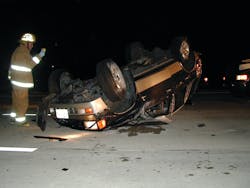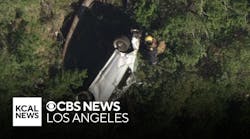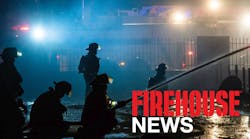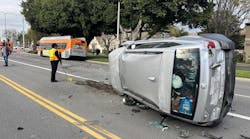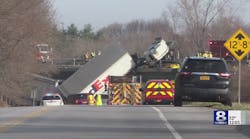SUBJECT: Patient Accountability at Crash Scenes
TOPIC: Thermal Imager Camera Use for Patient Accountability
OBJECTIVE: Given a scenario of a crash-damaged vehicle and unoccupied seats, the rescue team will be proficient at techniques to determine if all occupants of the vehicle are accounted for.
TASK: The rescue team shall conduct a skills practice session using a thermal imaging camera to observe the heat signature of a vehicle seat under various conditions
As fire department responders, it is not uncommon to find no occupants inside a crash-damaged vehicle when we arrive at a scene. Occupants might be uninjured and ambulatory at the scene. That would be the best scenario. On the other hand, we might find an empty seat with an open door or window, or worse yet, a blood-stained, empty seat. Depending on the situation, one or more occupants of the vehicle may have gotten out or were ejected during the collision especially if they were not wearing their seatbelt. These vehicle occupants need to be accurately accounted for by fire, rescue, and medical personnel.
Evidence of personal items that don’t appear to belong to the occupant is one telltale sign that someone might be missing. For example, a diaper bag in the back seat, child’s clothing scattered around, and an empty booster seat should immediately raise our suspicions that a small child might be missing and must be accounted for.
Our first effort to determine if everyone is accounted for typically begins with questioning the known occupants of the damaged vehicle. We might ask our patient during our initial assessment questions such as “Who else was riding with you?” or “Were you the only person in the vehicle?” If the answer is that our patient was the only occupant and physical evidence seems to reinforce that, then we can be more confident that all patients are accounted for.
We may however find that our initial patient has an altered mental state or might be unconscious. Without the ability to question our patient, we can resort to other methods. One possible source of information might be quick questioning of civilians at the incident scene. You might ask a witness “Did you see anyone else in this vehicle or anyone get out of this vehicle?” If they were witnesses to the collision or arrived just after the crash occurred, they may have seen something or someone or they might be able to verify that all occupants are present and accounted for.
When the initial patients cannot offer up any solid information and there are no witnesses, we can resort to some basic open-area search procedures. This is where some good detective work, physical searching of the surrounding area, and being alert to any indications of ejected persons will come in handy. Beginning at the vehicle, crews systematically begin searching the area around the incident scene in all directions.
Blood stains on the roadway, debris thrown in a certain direction by the crash, and articles of clothing found a distance away from the vehicle are all good indicators that someone who was originally inside the damaged vehicle might have been ejected during the crash towards this direction. You need to search for this area intently for a possible missing patient.
Back at the vehicle itself, a piece of firefighting equipment might prove itself to be very valuable as well. It may be possible to utilize your thermal imaging camera (TIC) and scan each empty seat of the damaged vehicle. In most cases, if a person were seated there prior to the collision, the seat back and bottom cushion will have a heat signature from that person’s body heat. Even with a heavy winter coat on, the bottom seat cushion may reveal a very distinct body-heat pattern.
If you use your thermal imaging camera to carefully scan an empty seat and there is no heat on the seat back or cushion, then the probability that the seat was occupied at the time of the crash is slim. If however, you scan the seat and see the distinct heat signature of a human form, then you most likely have a missing person. Initiate efforts immediately to account for at least this one missing patient. This same TIC technique can be used to determine if an injured motorcyclist was alone or had a passenger riding with them.
It is important to scan all vehicle seat positions once you find a heat signature on an empty seat inside a vehicle. Do not be distracted by discovering your first warm seat and stopping your TIC scanning. Remember that additional occupants may have been in the vehicle and need to be accounted for as well. At the scene, the TIC can also be valuable to scan the area immediately surrounding the crash scene. In a rural setting for example, the TIC might be able to see the heat signature of a patient in a field of high grass or a thick wooded area where they normally might be hidden from sight otherwise.
Training Exercise
Using member’s vehicles, conduct training with the department’s thermal imaging camera to determine its sensitivity to heat differences on various vehicle seats. Have a member sit in a seat for a given period of time and then use the TIC to observe the seat once your member gets off the seat. Experiment with cloth-covered seats compared to vinyl or leather seat upholstery. Try this drill in daylight with the sun shining on the seat cushion to determine the approximate life expectancy of the heat signature once the occupant exits and the seat is in direct sunlight. During cool nights, there is a longer timeframe in which you have to work with the TIC and still get reliable results. Warm weather and direct sunlight can seriously shorten your effective time. Experiment and find out for yourself.
TASK: The rescue team shall conduct a skills practice session using a thermal imaging camera to observe the heat signature of a vehicle seat under various conditions.
